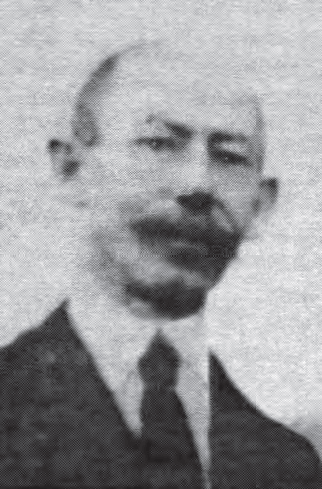
Jacob Raphael Cohen arrived in 1873.
After opening Florida stores in Bartow, Fort Meade and Fort Ogden in the 1860s, Cohen settled in Orlando. He bought property from Jacob Summerlin and operated a general merchandise store. Cohen loaned money to Pine Castle’s original settler Will Harney and received property in return, opening a store there, as well. Cohen remained in Orlando until December 1877 when he married Rachelle Williams and relocated to Tallahassee. He conducted the first statewide appeal for funds for Jews in Palestine, collecting $10,000 and was a delegate to the National Democratic Convention in 1901.
Collections of the Jewish Museum of Florida-FIU, originated by Marcia Jo Zerivitz, LHD, Founding Executive Director
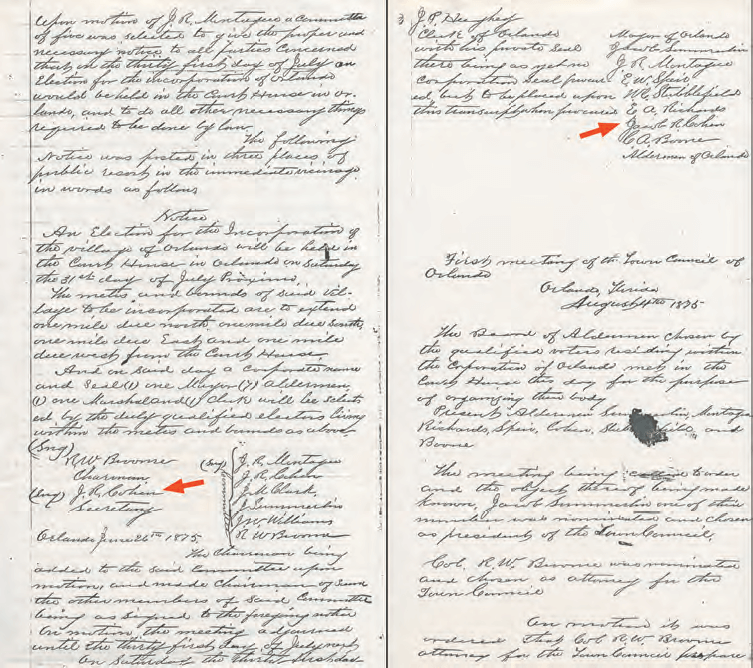
Jacob R. Cohen wrote the first minutes of the Town of Orlando, 1875.
He became active within the small group of qualified voters who formed the government. In 1875, he helped write the town charter and was elected alderman. In these first minutes of the Town of Orlando in August 1875, Cohen was requested to act as secretary for the meeting of incorporation. In 1886, another Jewish merchant A. H. Birnbaum was elected alderman and served as a member of Orlando’s first fire department.
Orlando City Hall
Article from the Sanford Journal about the brit milah (circumcision ceremony) for Louis Henry Cohen, November 15, 1883.
Dr. Marx Moses was the first rabbi of Florida’s second congregation, Ahavath Chesed, founded in Jacksonville in 1882. He likely traveled by paddleboat on the St. Johns River from Jacksonville to Sanford. This article, using the flowery journalistic language of the 19th century, gave Dr. Marx Moses an incorrect first name. The brit milah or bris ceremony is commanded for all Jewish boys in Genesis 17:10 and Leviticus 12:3. This is one of the most universally celebrated Jewish ceremonies, traditionally held on the eighth day of a Jewish boy’s life.
Sanford Museum
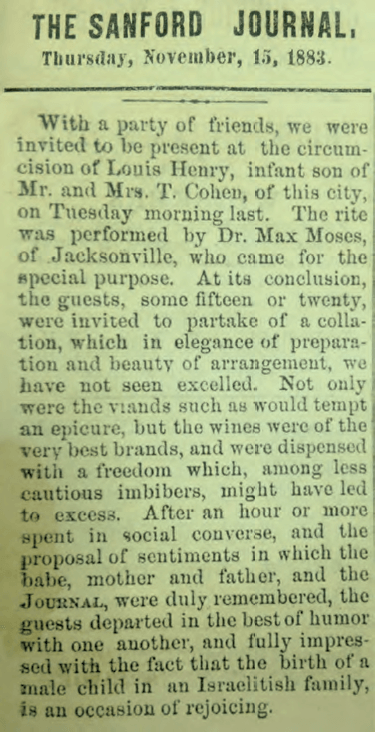
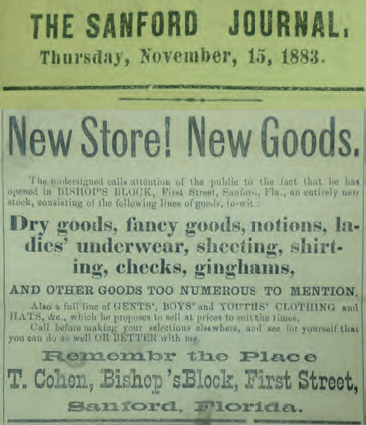
Mr. T. Cohen’s store ad in the Sanford Journal, November 15, 1883.
The father mentioned in the article (prior page) about the brit milah owned a dry goods store on First Street in Sanford.
Sanford Museum
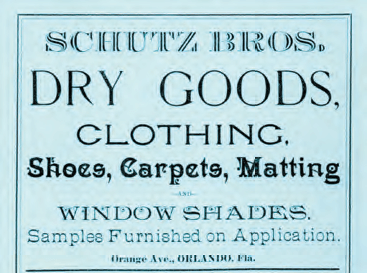
Schutz Bros. ad, 1886.
Webb’s City Directory
The Schutz brothers were in business by 1884.
Immigrants from Germany, Nathan, Max and Henry Schutz opened their dry goods store on the corner of Orange Avenue and Pine Street. They lived nearby at the Windsor Hotel where the rates were “$2.50 per day and upwards.” Nathan was secretary of the fire department, Hook and Ladder Co., No. 1, serving with A. H. Birnbaum. The brothers bought property that is a few blocks from today’s Dr. Phillips Center for the Performing Arts, but did not remain in Orlando.
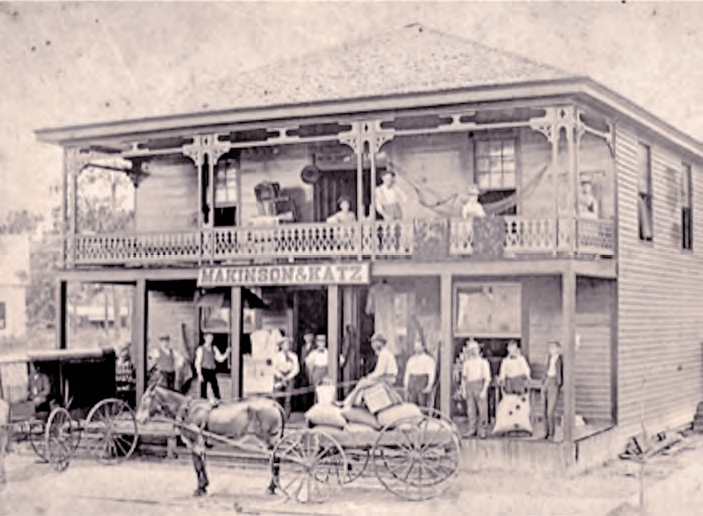
Makinson-Katz Hardware, founded in 1884 by W. B. Makinson and J. Moses Katz and located in the heart of downtown Kissimmee, is the oldest retail hardware store still in operation in the state of Florida.
After Makinson and Katz ended their partnership, Katz opened a clothing store on Broadway in the early 1900s. The two-story, wood-frame Makinson & Katz building at what today is Darlington Avenue and Pleasant Street later burned.
Collections of the Jewish Museum of Florida-FIU, originated by Marcia Jo Zerivitz, LHD, Founding Executive Director
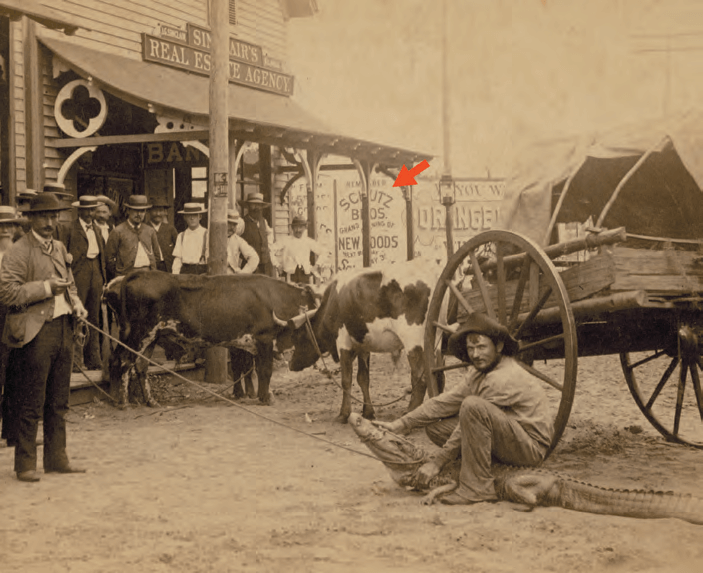
Schutz Bros. ad is slightly visible in the center background of this image of Orange Avenue on market day, c. 1884.
Collections of the Historical Society of Central Florida, Inc.
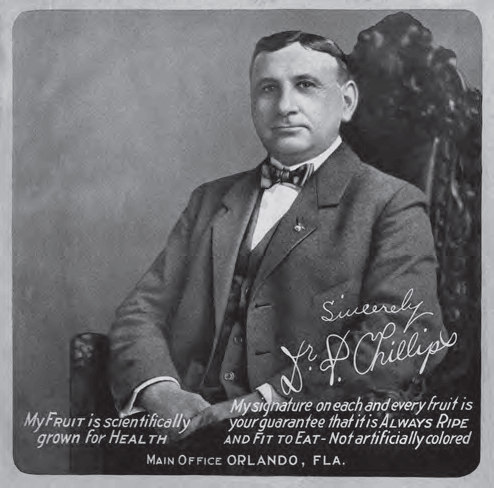
Dr. Philip P. Phillips earned a medical degreeat Columbia University and settled in Orlando, becoming a king of citrus with an empire of 5,000 acres and two packinghouses, c. 1926.
Dr. Phillips moved to Orlando in 1897 to buy land for citrus groves. By 1911, his yellow home on the north shore of Lake Lucerne became a landmark. In 1916, he built a $100,000 theater, called the Opera House, at Pine Street and Orange Avenue. Phillips and his wife Della Wolf Phillips hosted concerts in their home and contributed greatly to the cultural development of the city. The Phillips citrus business was sold in 1954, and his legacy continues to fund many charitable community projects.
Collections of the Historical Society of Central Florida, Inc.
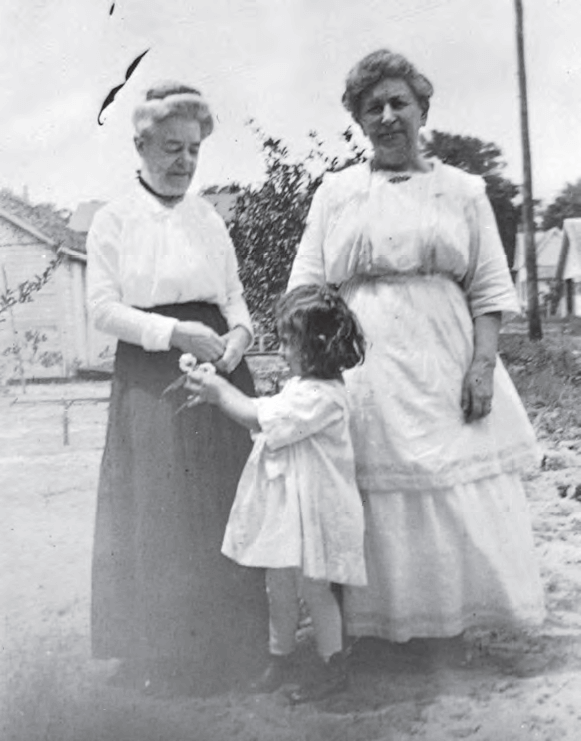
Orlando pioneers Sylvia Benedict, Mrs. Singer and Sylvia Berman [Prince], 1918.
German Jews Henry and Sylvia Benedict came around 1890 and sold wholesale dry goods and notions. Henry went into pineapple packing and became a downtown developer, owning property from the south side of Lake Eola to Rosalind Avenue. Sylvia Street (one block between Michigan and Kaley, east of Orange) was named for his godchild, Sylvia Berman [Prince], shown here at age four and a daughter of Pauline and Nat Berman.
Collections of the Jewish Museum of Florida-FIU, originated by Marcia Jo Zerivitz, LHD, Founding Executive Director
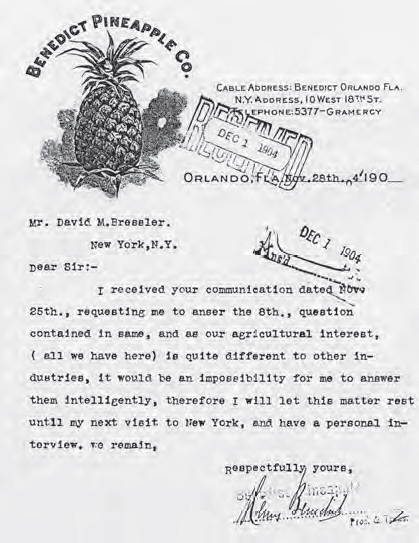
Henry Benedict responds to the Industrial Removal Office (IRO) in this letter about employees for his company, 1904.
The IRO, founded in New York City in 1901, moved Jewish immigrants from crowded eastern cities to communities throughout the United States. The program ran on a one-to-one personalized basis. The IRO had asked in a letter about “chances of harmonious relations between present employees and new Jewish employees before they will send him immigrants for employment.”
Collections of the Jewish Museum of Florida-FIU, originated by Marcia Jo Zerivitz, LHD, Founding Executive Director
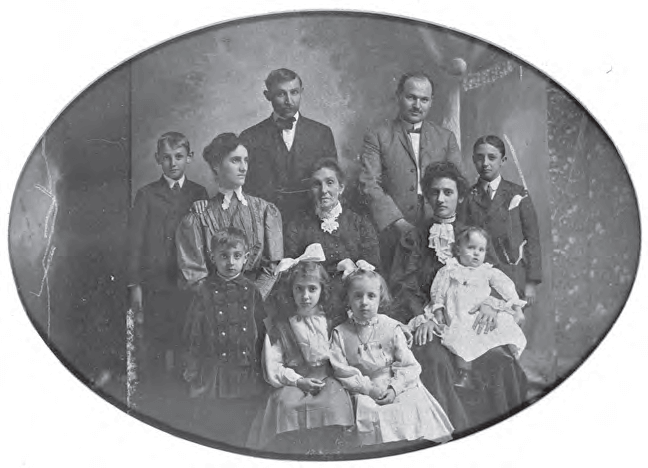 Kanner-Salomon family photo, 1905.
Kanner-Salomon family photo, 1905.
Charles Kanner arrived in Sanford in 1892 and brought from Romania his sweetheart Pauline Abrams. Their marriage in 1893 was the area’s first known Jewish wedding. Ben and Minnie Abrams Salomon arrived in Orlando in 1903, settling on South Street with no inside plumbing. The Salomons opened a store on N. Orange Avenue. Ben was a founder and president of Congregation Ohev Shalom. Minnie was the first president of the Ladies Auxiliary. Their children were Blanche, Morris, Helen, Thoba and Celia. Celia became a noted concert pianist and teacher in New York. Descendants of both families live in Florida. Sisters Pauline Abrams Kanner and Minnie Abrams Salomon with their mother (center), their husbands Charles Kanner and Ben Salomon (standing in the back) and their children. Front row L-R: Herman Kanner, Ruth Kanner [Sandler], Celia Salomon; second row L-R: Harry Kanner, Pauline Kanner, grandmother Abrams, Minnie Salomon with Blanche Salomon [Boolos] on lap, A. O. Kanner
Collections of the Jewish Museum of Florida-FIU, originated by Marcia Jo Zerivitz, LHD, Founding Executive Director
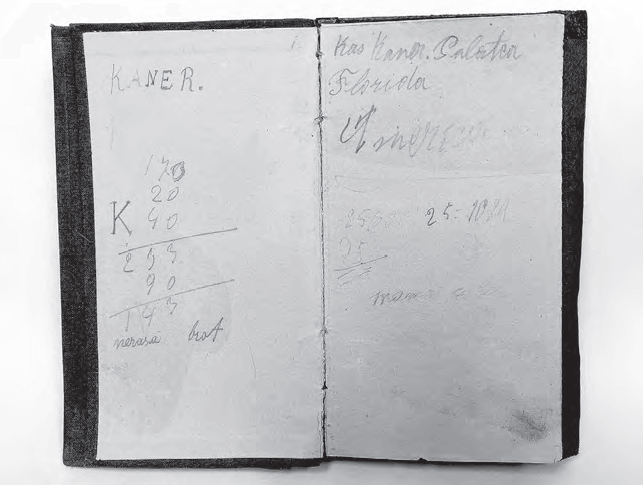 Harry Kanner brought this notebook to America to practice English, 1900.
Harry Kanner brought this notebook to America to practice English, 1900.
When Harry Kanner emigrated from Jassy, Romania, he practiced his name in English and the words “Palatka” (where his sister lived), “Florida” and “America.” His seven brothers and sisters lived in small towns in central and north Florida. Harry settled in Orlando in 1900. He spoke Romanian, Russian and Yiddish, but his English was proficient enough for him to open a shoe store here. He then brought from Romania his childhood sweetheart Rachel (Ray) Loben. They were married in 1902 by a rabbi from Jacksonville at the home of his brother Charles.
Collections of the Jewish Museum of Florida-FIU, originated by Marcia Jo Zerivitz, LHD, Founding Executive Director
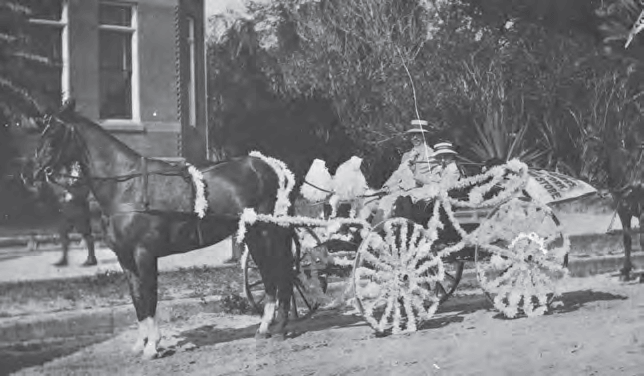 Harry Kanner rides with son Aaron in parade, 1912.
Harry Kanner rides with son Aaron in parade, 1912.
In his native Romania, Harry’s occupation was to purchase horses for royalty. In Orlando, he had trotters “Dan Patch” and “Melon Patch.” The family used the horse and buggy for Sunday outings to Palm Springs (the Springs subdivision) and to Wekiva Springs for swimming, and Harry participated in parades with his handsome buggy. Rachel and Harry had three children: Rose, 1904; Aaron, 1905 and Samuel, 1913.
Collections of the Jewish Museum of Florida-FIU, originated by Marcia Jo Zerivitz, LHD, Founding Executive Director
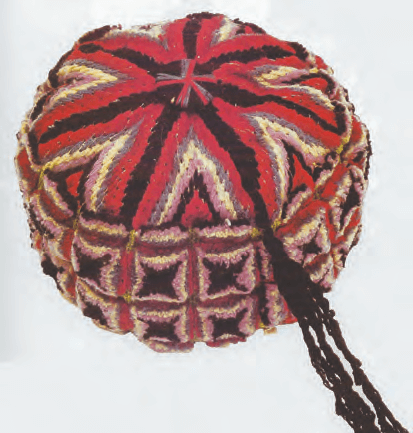
Rachel Kanner made this kippah for her son Aaron, 1907.
This hand crocheted kippah was an entry for the Orange County Fair, where Rachel was awarded a ribbon for craftsmanship. Jewish law requires men to cover their heads as a sign of respect and reverence for God when praying, studying Torah (first five books of the Hebrew Bible; the body of Jewish law and ritual tradition) or saying a blessing. Aaron graduated from Orlando High School in 1923, was a cofounder of Tau Epsilon Phi fraternity at the University of Florida and became a prominent attorney in Miami.
Collections of the Jewish Museum of Florida-FIU, originated by Marcia Jo Zerivitz, LHD, Founding Executive Director
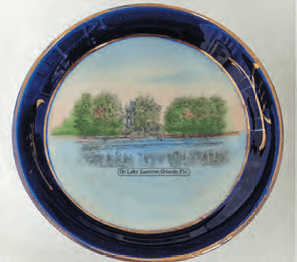
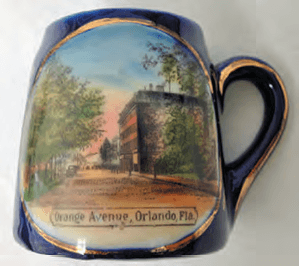
These are two pieces selected from Harry Kanner’s large collection of Orlando souvenir hand-painted china, c. 1910.
Kanner had deep civic pride in his new “hometown” in America. The plate at the top has printed, “On Lake Lucerne, Orlando, Fla” and the mug has “Orange Avenue, Orlando, Fla.”
Collections of the Jewish Museum of Florida-FIU, originated by Marcia Jo Zerivitz, LHD, Founding Executive Director
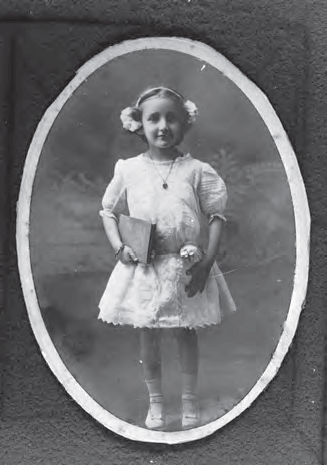
The first known Jewish child born in Orlando, Rose “Rosebud” Kanner is off to first grade, c. 1909.
Rosebud graduated from Orlando High School in 1921 and then enrolled in Rollins College. “Hebrew” is typed into the space for “church” on the college
registration form.
Collections of the Jewish Museum of Florida-FIU, originated by Marcia Jo Zerivitz, LHD, Founding Executive Director
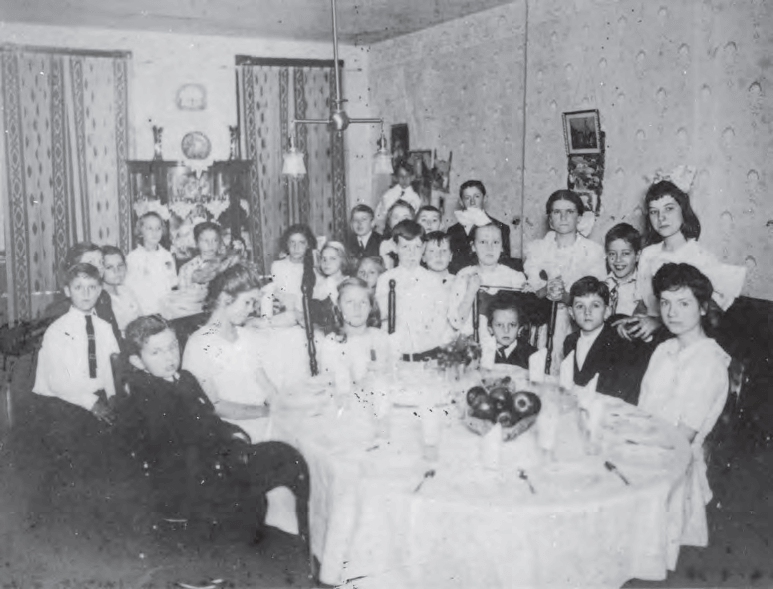
Rose “Rosebud” Kanner, back row, first left with bow in hair, celebrates her eighth birthday, 1912.
Her celebration included the other three Jewish children in Orlando, her brother Aaron and cousins Blanche and Morris Salomon and also the Jewish children in Sanford. Aaron’s son Lewis Kanner later became a law partner of Morris Salomon in Miami and the firm exists today. Rose ultimately resided in Coral Gables, FL, where she died in 1993.
Collections of the Jewish Museum of Florida-FIU, originated by Marcia Jo Zerivitz, LHD, Founding Executive Director
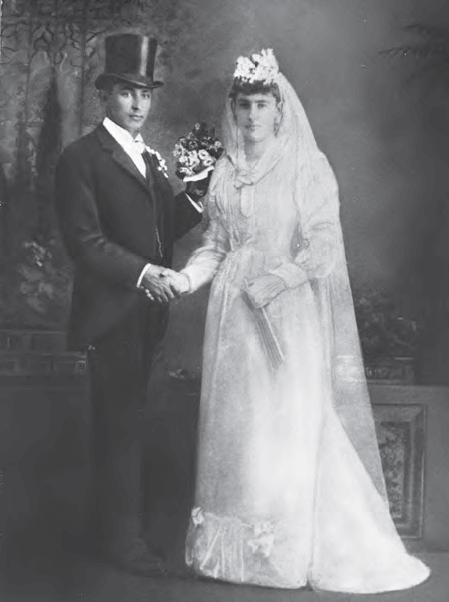
Pauline and Charles Kanner at wedding, Sanford, 1893.
Collections of the Jewish Museum of Florida-FIU, originated by Marcia Jo Zerivitz, LHD, Founding Executive Director
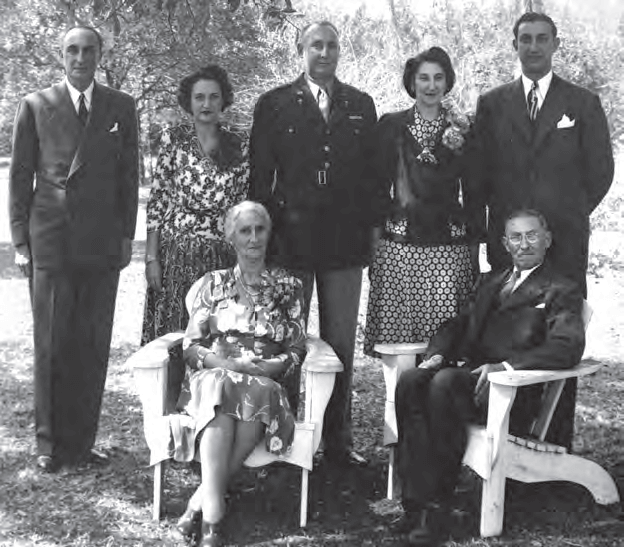
Charles and Pauline Kanner (seated) gather the family for their 50th wedding anniversary, 1943.
Charles Kanner, the second of eight Kanner siblings who came to Florida, was a peddler, then owner of a dry goods store and a farmer. In 1895, he lost his entire crop to a freeze, moved to Miami where he lost everything in a fire, then moved back to Sanford. In 1899, his parents Samuel and Esther Kanner came to live with them.
Standing L-R: Abram Otto A. O. (Florida senator and judge), Ann (teacher), Harry (physician), Ruth (first Jewish teacher in Seminole County) and Herman
Collections of the Jewish Museum of Florida-FIU, originated by Marcia Jo Zerivitz, LHD, Founding Executive Director
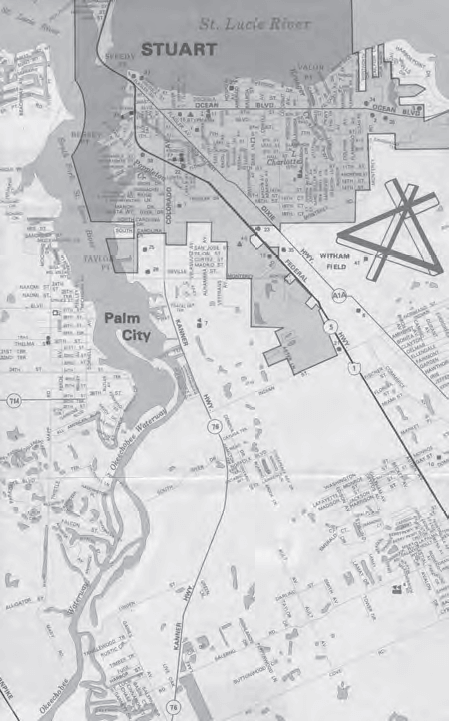
Kanner Highway (Route 76) was named for A. O. Kanner, 1945.
Kanner Highway runs 31.5 miles east-west in Martin County. A. O., born in Sanford in 1893, is the first known child to be born in Central Florida to a Jewish family that set down roots in the area. He had a 40-year political career in Florida. Kanner served as assistant state attorney (1925), state representative (1926–1935), senator (1937–1941) and then as appellate court judge (Ninth Judicial Circuit). His 1933 Kanner Act allowed Florida counties to use gas tax money to avoid bankruptcy and helped lift the state out of the Depression. Kanner was Exalted Ruler of the Elks, Worshipful Master of Masons and a Rotary president. He died in 1967.
Collections of the Jewish Museum of Florida-FIU, originated by Marcia Jo Zerivitz, LHD, Founding Executive Director
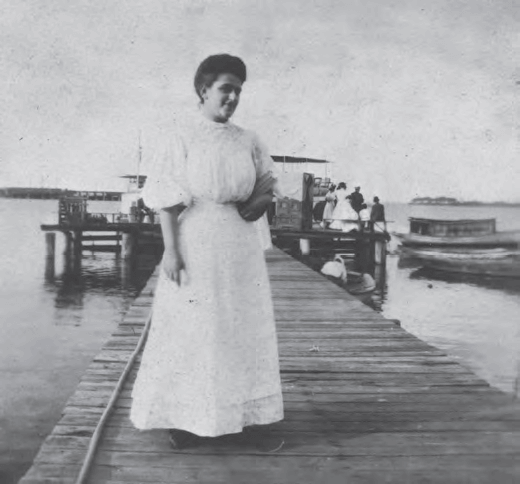 Pauline Klein Berman arrived with her husband Nat following their honeymoon, 1908.
Pauline Klein Berman arrived with her husband Nat following their honeymoon, 1908.
Pauline moved to Jacksonville in 1899. When she married Nat Berman and settled in Orlando in 1908, they were one of five Jewish families here. She and Nat owned and operated Berman’s Quality Store, Leader Department Store (with Harry Stahlberg), Youth Centre and Kiddie Korner. Long before it was common for women to be involved in business, Pauline was integral to the development and management of the stores. She was a major innovator and leader in the Jewish community and promoted understanding between Christians and Jews, founding many civic and Jewish organizations, including two Jewish congregations in Orlando.
Collections of the Jewish Museum of Florida-FIU, originated by Marcia Jo Zerivitz, LHD, Founding Executive Director
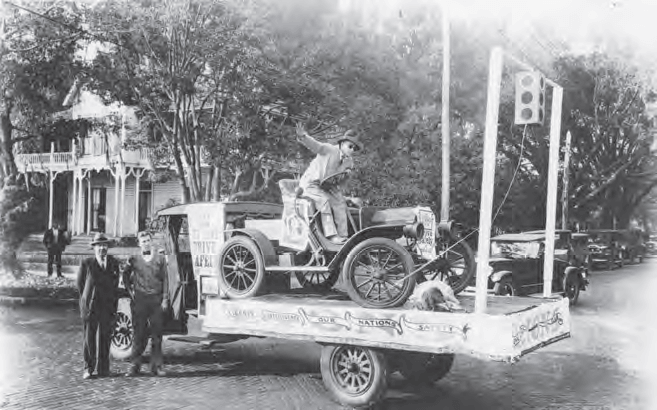 Nat Berman on his float as part of a Lions Club Parade on E. Robinson across from Lake Eola, 1921.
Nat Berman on his float as part of a Lions Club Parade on E. Robinson across from Lake Eola, 1921.
Berman was an immigrant from Russia who had settled in Jacksonville where he met Pauline Klein. He started his first business in 1908 and was very active both in the Jewish and civic communities. He was a founder and charter member of the Lion’s Club of Orlando, B’nai B’rith, Congregation Ohev Shalom and Congregation of Liberal Judaism. He was active with the Board of Trade (predecessor of the Chamber of Commerce), working with other merchants to promote the business interests of the city. Pauline and Nat Berman had two daughters: Sylvia [Prince] and Zelda [Gross]; both lived in Orlando.
Collections of the Jewish Museum of Florida-FIU, originated by Marcia Jo Zerivitz, LHD, Founding Executive Director
